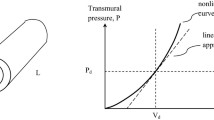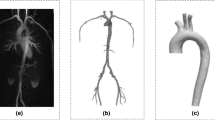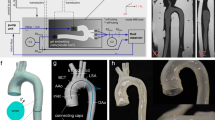Abstract
This investigation examined the feasibility of applying the conductance catheter technique for measurement of absolute aortic segmental volume. Aortic segment volume was estimated simultaneouslyin vitro by using the conductance catheter technique and sonomicrometer crystals. Experiments were performed in five isolated canine aortas. Vessel diameter and pressure were altered, as were the conductive properties of the surrounding medium. In addition, a three-dimensional finite-element model of the vessel and apparatus was developed to examine the electric field and parallel conductance volume under different experimental conditions. The results indicated that in the absence of parallel conductance volume, the conductance catheter technique predicted absolute changes in segmental volumes and segmental pressure-volume relationships that agreed closely with those determined by sonomicrometry. The introduction of parallel conductance volume added a significant offset error to measurements of volume made with the conductance catheter that were nonlinearly related to the conductive properties of the surrounding medium. The finite-element model was able to predict measured resistance and parallel conductance volume, which correlated strongly with those measuredin vitro. The results imply that absolute segmental volume and distensibility may be determined only if the parallel conductance volume is known. If the offset volume is not known precisely, the conductance catheter technique may still be applied to measure absolute changes in aortic segmental volume and compliance.
Similar content being viewed by others
References
Amirhamzeh, M. M. R., C.-X. Jia, and H. M. Spotnitz. Extrinsic factors influencing left ventricular conductance in situ.Circulation 90:II-347–II-352, 1994.
Appelgate, R. J., C. P. Cheng, and W. C. Little. Simultaneous conductance catheter and dimension assessment of left ventricle volume in the intact animal.Circulation 81: 638–648, 1990.
Baan, J., E. T. Van Der Velde, H. G. De Bruin, G. J. Smeenk, J. Koops, A. D. Van Duk, D. Temmerman, J. Senden, and B. Buis. Continuous measurement of left ventricular volume in animals and humans by conductance catheter.Circulation 70:812–823, 1984.
Ferguson, J. J., III, M. J. Miller, P. Sahagian, J. M. Aroesty, and R. G. McKay. Assessment of aortic pressure-volume relationships with an impedance catheter.Cathet. Cardiovasc. Diagn. 15:27–36, 1988.
Heringa, A., D. F. Stegeman, G. J. H. Uijen, and J. P. C. De Weerd. Solution methods of electrical field problems in physiology.IEEE Trans. Biomed. Eng. 29:34–42, 1982.
Kass, D. A., M. Midei, W. Graves, J. A. Brinker, and W. L. Maughan. Use of a conductance (volume) catheter and transient inferior vena caval occlusion for rapid determination of pressure-volume relationships in man.Cathet. Cardiovasc. Diagn. 15:192–202, 1988.
Kass, D. A., T. Yamazaki, D. Burkhoff, W. L. Maughan, and K. Sagawa. Determination of left ventricular end-systolic pressure-volume relationships by the conductance (volume) catheter technique.Circulation 73:586–595, 1986.
Kim, D. W., L. E. Baker, J. A. Pearce, and W. K. Kim. Origins of the impedance change in impedance cardiography by a three-dimensional finite element model.IEEE Trans. Syst. Man Cybern. 35:993–1000, 1988.
Lankford, E. B., D. A. Kass, W. L. Maughan, and A. A. Shoukas. Does volume catheter parallel conductance vary during a cardiac cycle?.Am. J. Physiol. 258:H1933-H1942, 1990.
Nichols, W. W., and M. F. O'Rouke.McDonald's Blood Flow in Arteries: Theoretic, Experimental and Clinical Principles. Philadelphia: Lea and Febiger, 1990, 456 pp.
Pagani, M., P. J. Schwartz, V. S. Bishop and A. Malliani. Reflex sympathetic changes in aortic diastolic pressure-diameter relationship.Am. J. Physiol. 229:286–290, 1975.
Peura, R. A., B. C. Penney, J. Arcuri, and F. A. Anderson, Jr. Influence of erythrocyte velocity on impedance plethysmographic measurements.Med. Biol. Eng. Comput. 16: 147–154, 1978.
Salo, R. W. The theoretical basis of a computational model for the determination of volume by impedance.Automedica 11: 299–310, 1989.
Salo, R. W., T. G. Wallner, and B. D. Pederson. Measurement of ventricular volume by intracardiac impedance: Theoretical and empirical approaches.IEEE Trans. Biomed. Eng. 33:189–195, 1986.
Sepulveda, N. G. Electric field distribution in three dimensional regions using the finite element method. PhD Dissertation, Tulane University, 1984.
Spinelli, J. C., and M.E. Valentinuzzi. Conductivity and geometrical factors affecting volume measurements with an impedancimetric catheter.Med. Biol. Eng. Comput. 24: 460–464, 1986.
Visser, K. R. Electric properties of flowing blood and impedance cardiography.Ann. Biomed. Eng. 17:463–473, 1989.
Woodard, J. C., C. D. Bertram, and B. S. Gow. Effect of radial position on volume measurements using the conductance catheter.Med. Biol. Eng. Comput. 27:25–32, 1989.
Ye, G.-F., T. W. Moore, and D. Jaron. Incorporating vessel taper and compliance properties in Navier-Stokes based blood flow models.Ann. Biomed. Eng. 21:97–106, 1993.
Author information
Authors and Affiliations
Rights and permissions
About this article
Cite this article
Hettrick, D.A., Battocletti, J.H., Ackmann, J.J. et al. In Vitro and finite-element model investigation of the conductance technique for measurement of aortic segmental volume. Ann Biomed Eng 24, 675–684 (1996). https://doi.org/10.1007/BF02684180
Received:
Revised:
Accepted:
Issue Date:
DOI: https://doi.org/10.1007/BF02684180




